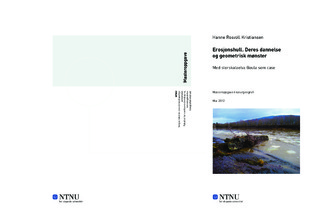| dc.contributor.advisor | Vatne, Geir | nb_NO |
| dc.contributor.author | Kristiansen, Hanne Rosvoll | nb_NO |
| dc.date.accessioned | 2014-12-19T14:26:14Z | |
| dc.date.available | 2014-12-19T14:26:14Z | |
| dc.date.created | 2013-04-24 | nb_NO |
| dc.date.issued | 2012 | nb_NO |
| dc.identifier | 617747 | nb_NO |
| dc.identifier.uri | http://hdl.handle.net/11250/265468 | |
| dc.description.abstract | Forced pools are a phenomenon discovered all over Norway. The effects of forced pools on river stability, and little research on the phenomenon in Norway, results in a need to know more about forced pools.
The approach to the problem is: Are there forced pools in Gaula, and has human intervention along Gaula been a contributing factor for development and preservation of forced pools? Is there a geometric spatial pattern in forced pools, and can these be compared to studies from smallscale-rivers?
The datamaterial goes back to 2007, when Hydra Team measured the center line. This data has been used to examine the geometry in the pools, while maps, pictures and other reports have given information about potential obstacles and the conditions in Gaula.
The results show that all of the eleven forced pools in Gaula are a result of an obstacle in the river which create erosion and development of forced pools. It seems that the embankment to prevent flooding and erosion on the riverbank is the main obstacle.
The analysis show a relation between the pools length and depth, where long pools are shallow and short pools are deep. The slope gradient has a relation to pool geometry, where a steep entry- and exit slope results in a deep and short pool, while a slack gradient gives a shallow and long pool. Pools located in riverbends are deeper than pools located along a straight part of the river. The results also show that the conditions of the obstacle; mainly its form, width and length, has an influence on the pool geometry.
The problem with scale and transfer of theory between scales is a challenge. This has been present in this thesis. Gaula is a largescale-river, while the theory and definitions are based upon small-scale river. | nb_NO |
| dc.language | nor | nb_NO |
| dc.publisher | Norges teknisk-naturvitenskapelige universitet, Fakultet for samfunnsvitenskap og teknologiledelse, Geografisk institutt | nb_NO |
| dc.title | Erosjonshull. Deres dannelse og geometrisk mønster: Med storskalaelva Gaula som case | nb_NO |
| dc.type | Master thesis | nb_NO |
| dc.contributor.department | Norges teknisk-naturvitenskapelige universitet, Fakultet for samfunnsvitenskap og teknologiledelse, Geografisk institutt | nb_NO |
